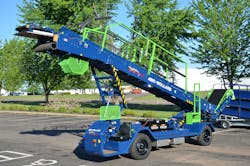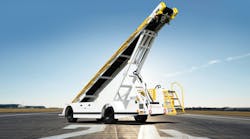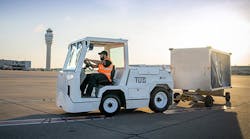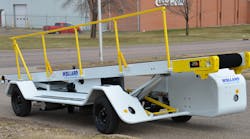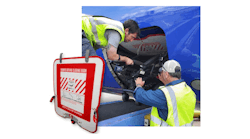It’s the age-old ground handler dilemma – how do you get baggage from the ground to the plane without breaking your back? Luckily, since 2008, ground handlers have needed neither super strength nor an exoskeleton to do the job, but instead a “mongoose.”
Introduced in 2008 as the Mongoose Belt Loader, Wollard International’s TC-999 Belt Loader has been helping save employees from back and knee injuries since it hit the market. Founded in the 1930s, Wollard International designs, manufactures, markets and services a broad line of aviation ground support equipment, industrial tow tractors and front-end articulated loaders/tool carriers. Their products can be found throughout the world supporting military operations as well as commercial and corporate aviation.
“The commercial aviation industry is safety focused. Employee injuries, primarily back and knee injuries, resulting from working in cramped, confined aircraft baggage storage areas prompted improvements to alleviate those injuries through technical solutions,” says Greg McDermott, president of Wollard International, on the TC-999’s conception. “The TC-999 is designed for the commercial carrier, specifically, to reduce aircraft turnaround times and minimize employee injuries handling heavy and awkward bags.”
Last year, the TC-999 was modernized with several key electrical and hydraulic systems upgraded to include technical innovations from the past decade and to simplify maintenance and servicing.
“The Mongoose has evolved and transformed into a technologically advanced piece of GSE. Electrical upgrades to the TC-999 based on automotive industry standards and manufacturing processes feature colored and marked wiring, automotive electrical connectors, circuit breakers and fuses, CANBUS communication between engine, transmission, smart switches and Belt Control Unit, LED lighting throughout the vehicle – in essence, the TC-999 is similar to working on a new car. Hydraulic components have been upgraded, a reservoir that utilizes a filter, fully integrated within the reservoir tank, eliminating external valves and hoses previously used,” describes McDermott.
One of the most recent upgrades to the TC-999 was the addition of a fully compliant IATA AHM913 collision avoidance system. The system monitors objects from 30 meters up to the point of aircraft interface, assuring that any and all contact with aircraft, other vehicles or personnel is avoided. Additionally, the TC-999 is available with optional baggage counting and RFID systems.
The infrared sensor system activates the brakes and reduces engine RPM, stopping the unit within 3 inches of an aircraft. Additional position sensors are engaged to confirm the handrails are stowed and the steering wheels are in the straight position to eliminate turn incursions while backing away from the aircraft.
The TC-999 is designed to be used with all commercial aircraft, and McDermott says the TC-999 has been tested with Boeing 737s and 767s and Airbus A320.
“Our engineering department designed the TC-999 using IATA aircraft standards for cargo entrance dimensions. The TC-999 is designed to eliminate one person from the baggage handling crew, freeing that person to perform more vital ground functions. And the fact that bags do not need to be thrown from the cargo door further into the aircraft will speed loading and unloading. To get the most out of a TC-999 an operator simply needs to purchase the unit. We will perform unit training upon delivery with the local baggage handlers and GSE maintenance technicians to optimize its daily performance. The TC-999 will prove itself through daily use on the flight line,” adds McDermott.
McDermott says that one of the key features of the TC-999 is its extending flexible belt and its ‘tipper head.’ The tipper head raises and lowers to adjust for ease of bag movement. The TC-999 is self-leveling, adjusting to the height of the cargo door entrance through built-in sensors. In the event of a breakdown, ramp ground crew can operate a built-in hand crank system to retrieve the flexible belt back into its storage location, allowing the unit to be moved away from the aircraft without involvement from GSE maintenance personnel.
“The TC-999 is specifically designed to bring safety, as well as time and labor efficiency, to the baggage handling task,” McDermott says. “Reliability, durability and ease of service further rationalize the decision to upgrade fleet baggage handling with a TC-999.”
